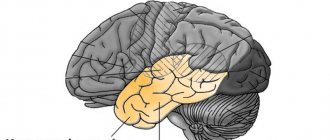Author: Sozinova A.V., obstetrician-gynecologist, has been in continuous practice since 2001.
Neonatal hypoxia is not considered a separate disease, but refers only to pathological conditions, that is, it is a manifestation of some congenital/acquired pathology or unfavorable course of pregnancy and childbirth.
Hypoxia necessarily accompanies respiratory distress syndrome, which often develops in premature infants. Moreover, the shorter the gestational age, the more severe this syndrome manifests itself.
So, hypoxia of the newborn is called oxygen starvation of the brain, which leads to its dysfunction, as well as other systemic disorders. Brain hypoxia poses a huge danger to a newborn and can lead to disability and even death.
Causes
The factors that provoke the development of hypoxia in the newborn are very numerous. Conventionally, they can be divided into 4 large groups:
Antenatal causes (acting during pregnancy)
These include:
- severe somatic diseases of the mother (cardiovascular, respiratory, endocrine pathology),
- chronic intoxication of a pregnant woman (smoking, drinking alcohol, using drugs, occupational hazards, disturbed ecology).
This list also includes:
- premature and post-term pregnancy,
- gestosis,
- severe pronounced anemia,
- bleeding during pregnancy (previa, placental abruption),
- intrauterine infection of the fetus with chronic maternal infections and acute infection suffered during pregnancy,
- polyhydramnios and oligohydramnios,
- multiple pregnancy.
In addition, hypoxia may be to blame for:
- Rhesus conflict pregnancy and antiphospholipid syndrome,
- permanent threat of miscarriage and development of fetoplacental insufficiency,
- constant stress, unfavorable living conditions, poor nutrition.
Intrapartum causes (complicated labor)
This group includes:
- protracted or, conversely, rapid labor,
- birth injury to the fetus (damage to the brain or spinal cord),
- labor stimulation with oxytocin,
- surgical delivery (application of obstetric forceps, caesarean section).
This group also includes:
- drop in blood pressure during childbirth,
- preeclampsia and eclampsia during childbirth,
- placental abruption during childbirth,
- hypoxia of a woman during general anesthesia,
- uterine ruptures,
- anomalies of labor (discoordination of labor forces).
Pathology from the umbilical cord
- true nodes and their tightening of the umbilical cord,
- rupture of the umbilical vessels,
- umbilical cord entanglement,
- umbilical cord compression.
Fetal causes (from the fetus).
These reasons include:
- hemolytic disease of the fetus and newborn (anemia due to hemolysis of red blood cells),
- fetal malformations (anomalies of the cardiovascular and pulmonary systems),
- infectious intrauterine diseases,
- hemorrhages in the brain, adrenal glands.
Asphyxia of the newborn
Asphyxia, which subsequently turns into hypoxia of the newborn, develops as a result of blockage of the respiratory tract (ingestion of amniotic fluid and meconium by the child, blockage of mucus, tight entanglement of the umbilical cord, prolonged and problematic birth of the head, and others).
Classification
The classification of types of hypoxia is based on several criteria - the causes of development, the speed of their development, the severity of disorders in the body, duration.
Due to development they distinguish:
- exogenous types of hypoxia (normal/hypobaric);
- endogenous types of hypoxia (respiratory, circulatory, hemic, tissue, overload type of hypoxia, substrate type of hypoxia, mixed hypoxia).
According to the severity of disorders of the body's vital functions, they are distinguished:
- mild degree;
- moderate (average) degree;
- severe;
- critical (lethal).
Based on the speed of occurrence/duration of the hypoxic state, the following are distinguished:
- Lightning—occurs within seconds after exposure to the causative factor.
- Acute - develops within a few minutes after exposure to the causative factor (acute respiratory failure, acute blood loss).
- Subacute - develops over several hours within the first day (in case of poisoning with benzene, nitrates, nitrogen oxides).
- Chronic - development period from several days to several years (with respiratory/heart failure, chronic anemia).
Signs of hypoxia. Apgar score
The baby's condition is assessed immediately after birth, in the first minute and 5 minutes later. For this purpose, a scale developed by Virginia Apgar is used, taking into account and summing up the following indicators, each of which is scored from 0 to 2 points:
- skin coloring;
- breathing rate;
- reflex activity;
- heart rate;
- muscle tone.
Based on the score obtained, the absence or presence of hypoxia and its degree are determined:
- norm – number of points 8-10;
- mild hypoxia – 6-7 points;
- moderate hypoxia – 4-5 points;
- severe hypoxia – 0-3 points.
Mild hypoxia is detected in almost all newborns in the first minute of life and disappears within 5 minutes on its own.
Moderate hypoxia in a newborn requires certain treatment; the child’s condition returns to normal after a few days. In case of severe hypoxia or asphyxia, immediate resuscitation measures are carried out, complex treatment and further monitoring of the child are prescribed.
The clinical picture of neonatal hypoxia is usually pronounced and the diagnosis is established immediately after the birth of the child. Signs of this condition include tachycardia, with gradual replacement by bradycardia (less than 100 beats per minute), irregular heartbeat, auscultation of heart murmurs, pallor of the skin and cyanosis of the nasolabial triangle and extremities.
Irregular breathing or its absence is noted, motor activity is reduced or absent (the child is lethargic or does not move), and the presence of meconium (green water) in the amniotic fluid. Blood clotting rates increase, which leads to thrombosis in the vessels and hemorrhage in the tissue.
Subsequently, if hypoxia was missed in the first minutes of the child’s life, the following signs are added:
- constant drowsiness;
- restless sleep, trembling;
- marbled skin tone of the extremities;
- the child freezes quickly (when bathing, changing clothes);
- restless, capricious behavior, causeless crying;
- trembling of the facial muscles while crying or at rest.
Hypoxic encephalopathy
Hypoxia in a newborn leads to the development of hypoxic encephalopathy (brain damage), which is divided into degrees of severity:
mild – drowsiness or agitation of the newborn, disappearing after 5-7 days;
moderate - in addition to drowsiness and/or agitation, there is crying for no reason, convulsions, aversion to being carried, rapid freezing;
severe - severe drowsiness and lethargy, development of psychomotor agitation or coma with ongoing convulsions.
Pathogenesis
Since the pathogenesis of each type of hypoxia is different and it is not possible to consider them within the scope of the article, we will consider only exogenous hypoxia. Regardless of the cause of this type of hypoxia, the main links in its pathogenesis include:
- Arterial hypoxemia . A decrease in O2 tension in arterial blood is the initiating and main element of exogenous hypoxia. Developing hypoxemia leads to a decrease in hemoglobin oxygen saturation and total oxygen content in the blood, which causes metabolic/gas exchange disorders in tissues.
- Hypocapnia (decreased carbon dioxide tension in the blood). Occurs as a result of compensatory hyperventilation of the lungs caused by hypoxemia.
- Gas alkalosis as a result of hypocapnia , followed by acidosis .
- Arterial hypotension . A decrease in systemic blood pressure, combined with tissue hypoperfusion. CO2 is one of the main regulators of cerebral vascular tone, and a pronounced decrease in CO2 causes a narrowing of the lumen of brain arterioles and heart vessels and a significant decrease in their blood supply. Such changes cause disorders of the body's functioning (fainting/coronary insufficiency).
- Simultaneously with such deviations, an imbalance in the ion balance occurs ( hypernatremia / hypocalcemia / hypokalemia ) in biological fluids and tissue cells (in the intercellular fluid, cerebrospinal fluid, lymph, blood plasma).
Therapeutic tactics of hypoxia
If fetal hypoxia occurs during the period of pushing or during contractions (decrease in heartbeat), a decision is made to complete the labor as soon as possible: a cesarean section or the application of obstetric forceps (in the case of labor stimulation with oxytocin, the administration of the drug is stopped). After the birth of the child, immediate medical care begins:
- clearing the respiratory tract from mucus, meconium and water (suction with a special aspirator);
- supplying a mixture of oxygen with air or pure humidified oxygen through a mask, nasal catheter or mechanical ventilation device (in case of severe hypoxia, the newborn is placed in an incubator, intubated and mechanical ventilation is started);
- heating the baby with radiant heat (on a special changing table), and in case of severe hypoxia, placing the baby in an incubator;
- administration of drugs that stimulate blood circulation and increase blood pressure (camphor, dopamine) and drugs that stimulate the respiratory center (etimizole);
- intravenous infusions solution, sodium bicarbonate (neutralization of carbon dioxide in the blood), glucose to restore the reduced volume of the vascular bed;
- transfusion of blood products if necessary (hemolytic disease of the newborn);
- prescribing antibiotics to prevent pulmonary infections in case of severe hypoxia or intrauterine infection of the fetus, as well as in respiratory distress syndrome during premature birth;
- prescription of anticonvulsants (phenobarbital, phenazepam);
- To reduce intracranial pressure, administration of diacarb and veroshpiron (diuretics with the effect of reducing cerebrospinal fluid production) is indicated.
Prevention
Prevention of AMS should first involve assessing the degree of risk individually for each participant going to high altitude (see table below).
For a low-risk individual, there is no need for prophylactic medications and participants should focus on following a gradual climb schedule. Thus, at altitudes of 3000 meters or more, participants should not increase the altitude of their overnight stop by more than 500 meters/day with a mandatory rest day. If it is impossible to comply with this requirement (relief and other factors do not allow it), it is recommended to arrange a rest day immediately before a large climb or immediately after it at the nearest point with the expectation that the total rate of climb over the period covered will be below 500 meters/day.
A stepped climb/pre-acclimatization significantly reduces the risk of developing mountain sickness, improves oxygenation/ventilation, and reduces the increase in pressure in the pulmonary artery during subsequent climbs.
Individuals at moderate/high risk of developing AMS are recommended to take the mountain sickness tablet Dexamethasone . Doses for adults are 2 mg every 6 hours or 4 mg every 12 hours. Higher doses (4 mg every 6 hours) should only be prescribed in high-risk situations. In this case, the duration of taking dexamethasone in order to avoid suppression of adrenal function/development of glucocorticoid intoxication should not exceed 10 days.
Acetazolamide ( Diacarb ) is also quite effective in preventing AMS (125 mg tablets 2 times a day). However, it is necessary to carefully monitor doses, since increasing them is accompanied by a high risk of side effects. Nifedipine , Tadalafil , Sildenafil are indicated for the prevention of high-altitude pulmonary edema .
The use of other drugs (coca tea, chewing coca leaves, leukotriene receptor blockers, antioxidants, phosphodiesterase inhibitors, Spironolactone / Sumatriptan , salicylic acid ) does not have a positive effect in the prevention of AMS.
Overhydration (increased drinking regimen) also did not demonstrate a positive effect in the prevention of AMS, but at the same time, the risk of hyponatremia .
Some authors believe that resistance to hypoxia is expressed during exercise in special masks, which, in their opinion, imitate hypoxic conditions.
The oxygen deprivation mask restricts the air flow entering the nose/mouth, thereby attempting to simulate the effect of training at high altitudes. At the same time, the mask has a mechanism for regulating the flow of air, which allows for altitudes from 900 to 5500 meters. According to the manufacturer, the use of masks allows you to achieve a significant increase in the key marker of growth in aerobic endurance - VO2max.
However, to date, the effectiveness of using training masks has been studied extremely poorly and many believe that a training mask has nothing to do with hiking in high altitudes. Despite the fact that it is difficult to breathe both at high altitudes and in a mask, the reasons for this are completely different: at high altitudes there is less oxygen in the air, but when using a mask, the oxygen does not become less. It is simply harder for a person to breathe. Therefore, masks cannot be considered a sports accessory that simulates hiking in the highlands. Rather, they can be considered as a simulator used to strengthen the inspiratory muscles involved in the act of inhalation.
Rehabilitation after discharge
Further treatment after discharge from the maternity hospital (the child’s condition is satisfactory) is carried out by a local neonatologist, who prescribes massage, therapeutic exercises, feeding regimen and explains to the woman the rules for caring for a child who has experienced hypoxia after birth.
Medicines prescribed include drugs that improve blood circulation and nutrition of the brain (vinpocetine, piracetam, cerebrolysin), drugs that reduce intracranial pressure (diacarb, asparkam, potassium-containing drugs), and anticonvulsants according to indications.
The child is being monitored by a pediatrician and must be regularly examined by a neurologist.
Consequences and prognosis
Mild and moderate hypoxia with timely and high-quality treatment does not lead to serious consequences, but severe hypoxia is dangerous due to the development of the following conditions:
- anxiety, restlessness of the child and mental lability;
- retardation in physical and mental development, headaches and development of neurocirculatory dystonia;
- increased intracranial pressure;
- development of epileptic syndrome and hydrocephalus;
- formation of brain cysts;
- damage to the cranial nerves and loss of their functions.
Rare consequences of severe hypoxia in a newborn include disability of the child or death.
The prognosis depends on the degree of hypoxia. With mild and moderate hypoxia and adequate therapy, the prognosis is favorable; with severe brain hypoxia, the prognosis is questionable.
Symptoms of poor blood circulation in the brain
There are acute (CVA - stroke) and chronic (CDC - dyscirculatory encephalopathy) cerebrovascular accident (CVA).
The following symptoms are characteristic of OMNC:
- sudden weakness, stupor;
- short-term loss of consciousness;
- numbness of the face, arms, legs;
- headache;
- dizziness;
- dry mouth;
- sweating;
- nausea, vomiting;
- disorientation;
- deterioration of speech.
With CNMK the following symptoms develop:
- memory impairment;
- changes in the emotional sphere;
- headache;
- dizziness;
- movement disorders, including changes in gait, frequent falls;
- decrease in intellectual activity, social adaptation;
- speech defects;
- dementia (dementia).










